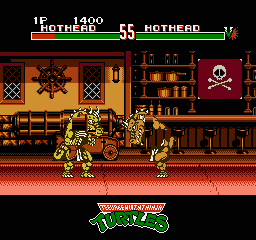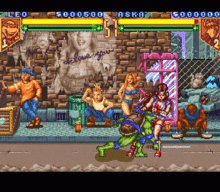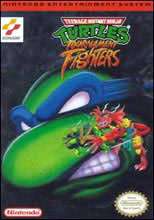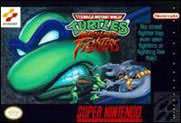Teenage Mutant Ninja Turtles: Tournament Fighters
Teenage Mutant Ninja Turtles: Tournament Fighters, or Teenage Mutant Hero Turtles: Tournament Fighters in Europe, is the title of three different fighting games based on the characters the Teenage Mutant Ninja Turtles, produced by Konami for the Nintendo Entertainment System, Mega Drive/Genesis, and Super NES and released during a period between 1993 and 1994. Konami produced a different fighting game based on the franchise for each platform, featuring a differing cast of characters.
Nintendo Entertainment System version
| Teenage Mutant Ninja Turtles: Tournament Fighters | |
|---|---|
|
NES version with Leonardo on the cover | |
| Developer(s) | Konami |
| Publisher(s) | Konami |
| Distributor(s) | Mattel |
| Composer(s) |
Junichiro Kaneda Ayako Nishigaki |
| Series | Teenage Mutant Ninja Turtles |
| Platform(s) | NES |
| Release date(s) |
|
| Genre(s) | Fighting game |
| Mode(s) | 1 or 2 players |

The NES version of Tournament Fighters was the final game Konami released for the platform in North America and the PAL region in 1994. Unlike the other versions of Tournament Fighters, it was not released in Japan. Tournament Fighters was one of the few fighting games released for the NES during the fighting game boom.
The game's single-player Story mode has the player taking control of one of the four Turtles (Leonardo, Raphael, Michaelangelo, and Donatello), as they hold a contest amongst themselves to see who is fit to take on Shredder's challenge. After defeating the first three opponents, the player proceeds to fight Casey Jones and then Hothead (a character based on the Dragon Warrior from the Teenage Mutant Ninja Turtles Adventures comics and the action figure of the same name) before the final match with the Shredder. In addition to the Story mode, the game also has two Versus modes (one against the CPU and another against a second player), as well as a four-player tournament mode. An option mode where the player can adjust the game's difficulty, continues, and speed is also available.
The gameplay follows many of the standard fighting game conventions. Battles consist of three-round matches and the first player to win two rounds is the victor. Each character has their own repertoire of basic punch and kick techniques, as well as command-based special moves. During battle, a flying monitor with Splinter's face will sometime appear that will drop a red ball power-up at the middle of the stage that can be retrieved by either fighter. Whoever retrieves the ball power-up will be able to use it by inputting the appropriate command.
The NES version allows the player to match any character against a clone of himself, with the exception of Hothead. The game doesn't allow such a match under normal circumstances, but there's a way to bypass this restriction in the game's "Vs. CPU" mode. The second Hothead will be colored differently, as with all same character matches in the game, but the game will also flicker due to the large size of both characters.
Super NES version
| Teenage Mutant Ninja Turtles: Tournament Fighters | |
|---|---|
|
SNES version, with Donatello on the cover. | |
| Developer(s) | Konami |
| Publisher(s) | Konami |
| Distributor(s) | Mattel (Australia) |
| Composer(s) | Kazuhiko Uehara, Hideto Inoue, Harumi Ueko |
| Series | Teenage Mutant Ninja Turtles |
| Platform(s) | Super NES |
| Release date(s) |
|
| Genre(s) | Fighting game |
| Mode(s) | 1 or 2 players |

The SNES version of Tournament Fighters is sometimes sold under the unofficial title Teenage Mutant Ninja Turtles V: Tournament Fighters[1] in order to continue the numbering from the earlier Turtles games released on the Nintendo Entertainment System as well as the Super NES, and is often considered by fans as the last game in the original Teenage Mutant Ninja Turtles series.
A tournament has been organized and many fighters have entered, Shredder being one of them. The Turtles decide to participate in order to stop their nemesis as well as proving their strength in the tournament.
This game's controls uses a four-button scheme (two punches and two kicks, weak and strong). A particular feature is the possibility to use a super special attack. In order to achieve this, the player must fill a green bar under the life bar, by hitting their opponents. Once full, the player must press the two strong attack buttons simultaneously. There is also the option of enhancing the speed of the game, making the fights more intense but also harder to follow.
In addition to the main and versus modes, there is a story mode in which the Turtles must rescue April O'Neil and Splinter from Shredder's clutches. The Turtles must travel across the US in their Turtle Blimp, defeating other fighters and collecting information. Only the four of them can be playable whereas the other characters (as well as a turtle clone) are the opponents. There is no Mutagen Meter in story mode. There is also a watch mode, which features computer controlled characters.
There are ten characters available, and two bosses. Aside from the Turtles and Shredder (who goes under the name of Cyber Shredder in this game), these characters are also available:
- War – A monstrous purple creature with big claws, one of the Four Horsemen of the Apocalypse from the Teenage Mutant Ninja Turtles Adventures comics published by Archie. The game version of the character is said to be an alien in the games Tournament mode as well as a mutant by the Turtles in the games story mode.
- Aska – A ninja girl seeking to open her own dojo. Aska is an original character (created by Takemasa Miyoshi) who makes her first and only appearance in the franchise. Possibly inspired by Mitsu from the film Teenage Mutant Ninja Turtles III.[2]
- Wingnut – A humanoid, alien bat who appeared in several issues of the Archie Comics series, as well as in an episode of the animated series.
- Chrome Dome – An android from the animated series, he was initially created by Shredder to destroy the Turtles.
- Armaggon – A mutant shark from the future. Also from the Archie Comics series.
The bosses are:
- Rat King – A deranged man who cast away his humanity and considers himself a rat even though he has not been mutated.
- Karai – The female leader of the Foot Clan in Japan. She only appeared in the original comics by Mirage Studios at the time of the game's release.
Regional differences
The Super NES version of Tournament Fighters was released in Japan under the different title of Teenage Mutant Ninja Turtles: Mutant Warriors.
- In story mode the Turtle Blimp actually displays the logo and the background is day time.
- The voice of the announcer, as well as the four Turtles, are different. The voices of the Turtles in the Japanese version sound less rough, with attack names sounding more clear. Some voice clips were taken from the Arcade version of Teenage Mutant Ninja Turtles: Turtles in Time.
- The music in the beginning plays at the proper length.
- You can select a character's 2nd player palette by pressing the Start button on the character select screen
- Some of character portraits are drawn differently in the Japanese release (such as Donatello's, Karai's and Wingnut's).
- Some of the character special attacks have been tweaked, such as Aska's double-hitting uppercut.
- In Rat King's stage (Studio 6), the fighters can break the walls and expand the arena.
- Aska's sprites underwent several modifications. In the Japanese version, her leotard is in form of a thong, exposing her rear when she does a spin or a high kick. In the overseas versions, they were originally bloomers. Moreover, her victory animation and pose is different. In the overseas version, Aska stands with arms crossed while butterflies surround her (an animation recycled from one of her special moves). In the Japanese version, she raises her arm in victory while her breasts bounce.
Mega Drive version
| Teenage Mutant Ninja Turtles: Tournament Fighters | |
|---|---|
|
Genesis version with Raphael on the cover. | |
| Developer(s) | Konami |
| Publisher(s) | Konami |
| Distributor(s) | Mattel |
| Composer(s) | Miki Higashino |
| Series | Teenage Mutant Ninja Turtles |
| Platform(s) | Mega Drive/Genesis |
| Release date(s) |
|
| Genre(s) | Fighting game |
| Mode(s) | 1 or 2 players |

The Mega Drive/Genesis version of Tournament Fighters was released in North America, the PAL region, and Japan around the same time as its SNES counterpart.
The Mega Drive/Genesis version uses the standard three-button controller, with only two buttons for attacking (punch and kick). To perform stronger punches or kicks, the player must hold the directional pad towards the opponent while pressing either attack buttons. The third button is used for taunting. Some of the stages in the game feature destroyable scenery that gives the player and their opponent access to new areas in the stage. As well as their special moves, each character has a 'killer' attack which is only accessible when they are close to death and the red part of the characters' life gauge at the top starts flashing. This is done by pressing the Taunt button in conjunction with a specific D-Pad motion. These moves nearly take out the other characters life gauge completely.
The game has eight playable characters, which includes the four Turtles and Casey Jones, as well as April O'Neil (whose active role differs from the versions of the character featured in other games), Ray Fillet (a character from the Teenage Mutant Ninja Turtles Adventures comics), and Sisyphus (an original character, named Musha Beetle in the Japanese version). The player can adjust their power and speed after selecting their character. The music in this version was composed by renowned videogame composer Miki Higashino, in collaboration with Masanori Adachi.[3]
The main single player mode features the turtles and their allies traveling to various planets in Dimension X, fighting against clones of themselves, as they seek to rescue Splinter from Krang. After defeating the eight clones, the player travel to the final three stages to fight against a Triceraton, Krang's Android, and Karai (in that order). The game has a two player mode, as well as a practice mode in which the player faces the computer in a 1-round match, and a "Tournament" where the player must defeat 88 opponents with one life gauge.
Reception
In 1993, Aska was rated as #4 on the list of "Top Ten Fighting Women" by Electronic Gaming Monthly.[4]
References
- ↑ http://www.gamestop.com/games/teenage-mutant-ninja-turtles-v-tournament-fighter/122813
- ↑ http://www.hardcoregaming101.net/tmnt/tmnt8.htm
- ↑ "Game Music :: Interview with Miki Higashino (January 2012)". Squareenixmusic.com. Retrieved 2013-09-01.
- ↑ EGM 53 (December 1993), page 66


